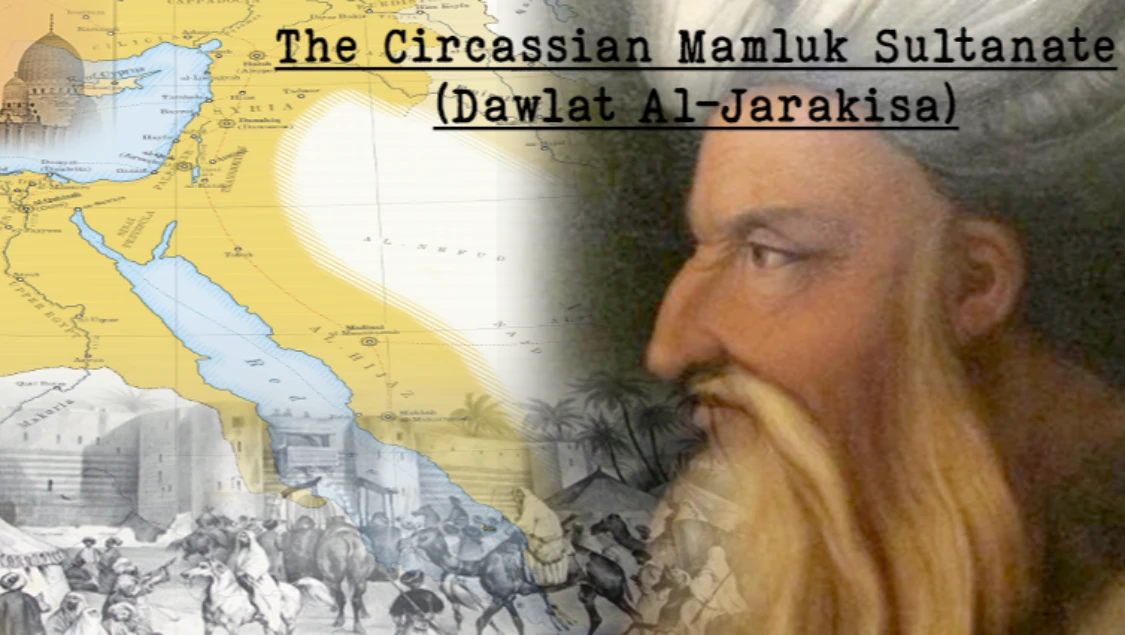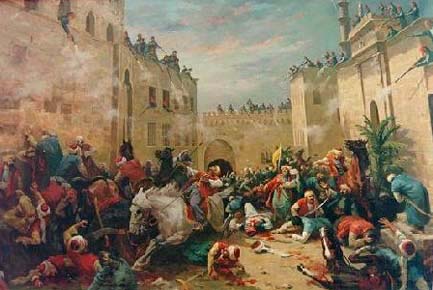 During the reign of Bahri dynasty of Mamluks in Egypt a revolt broke out in Syria which spread to Egypt in 1377. As the result of the revolt the government was taken over by Barquq who was proclaimed Sultan in 1382 and founded the Burji (Circassian) dynasty.
During the reign of Bahri dynasty of Mamluks in Egypt a revolt broke out in Syria which spread to Egypt in 1377. As the result of the revolt the government was taken over by Barquq who was proclaimed Sultan in 1382 and founded the Burji (Circassian) dynasty.Faced with a common enemy, Barquq joined with Bayezid I and Toktamish in a combined resistance against Tamerlane. After Barquq’s death in 1399. Tamerlane invaded Syria and sacked Aleppo, and Damascus in 1401. Syria was regained by Barquq's son, Sultan Faraj, after Timur died in 1405. But Faraj faced constant rebellions from the Amirs there and he was forced to abdicate in 1412. After Faraj, the Abbasid caliph al-Musta'in ruled the sultanate in Cairo for few months, but the role of sultan was soon taken by another Mamluk, Al-Mu'ayyad Shaykh.
Under the reign of Sultan Barasbiy, the Mamluk Sultanate grew to its widest territorial extent. In 1426, he invaded the Kingdom of Cyprus and forced its kings to become Mamluk vassals. After Barasbiy’s death in 1438, the new Sultan, Sayf ad-Din Jaqmaq attempted to conquer Rhodes Island in 1444 from the Knights of St. John but was repelled. Sayf ad-Din Inal came to power in 1453 and had friendly relations with the Ottoman Sultan Mehmed II (The Conqueror), However, the relationship between the Ottomans and the Mamluks became more adversarial after the conquest of Constantinople. Both states constantly vied for control of the spice trade, and the Ottomans aspired to eventually take control of the Holy Cities of Islam. Under the reign of Khusqadam tensions increased. After the death of Mehmed II, Sultan Qaitbay offended the Ottoman sultan Bayezid II by harboring his rebellious brother, Cem in 1481. After Qaitbay’s death in 1496 and following several years of political instability the last major Mamluk Sultan, Kanshau Gur’i (Qansuh al-Ghawri) came to power in 1501. While he attempted some reforms, including the introduction of the first military regiment with gunpowder weapons, he was unable to fully integrate them into the Mamluk army and he could not fix the country's economic problems.
The Ottomans who had overcome other troubles with the Safavids by 1516, turned their full might against the Mamluks. Kanshau Gur’i led his army to confront Selim I's invasion of Syria in 1516, but he died in the Battle of Marj Dabiq. In 1517, the Ottomans completed their conquest with the capture of Cairo on January 22. The center of power transferred from Cairo to Constantinople. While the Mamluk Sultanate ceased to exist, the Circassian Mamluks as a military-social class continued to exist. They constituted a "self-perpetuating, warrior class" that continued to influence politics in Egypt under Ottoman rule. Up to the early 17th century, the vast majority of Mamluks were still of Caucasian origin.
Throughout the Ottoman period, powerful mamluk households and factions struggled against each other for control of important political offices and of Egypt's revenues. Despite the temporary French invasion in Egypt, Circassian Mamluk managed their reign though had been weakened, but not destroyed. Ottoman forces clashed with the Mamluks for power and Ottoman Pasha, Muhammad Ali used his loyal Albanian troops during the clashes between 1801 and 1805. The Circassian Mamluks was posing the greatest threat to Muhammad Ali Pasha. Egypt was under control of the Circassian mamluks for more than 600 years, and over that time they extended their rule systematically south along the Nile River to Upper Egypt. Muhammad Ali's approach was to eliminate the Mamluk leadership, then move against the rank and file. Muhammad Ali invited the Mamluk leaders to a celebration at the Cairo Citadel in honor of his son, Tosoun Pasha, who was to lead a military expedition into Arabia. The event was held on 1 March 1811. When the Mamluks had gathered at the Citadel, they were surrounded and killed by Muhammad Ali's troops. After the leaders were killed, Muhammad Ali dispatched his army throughout Egypt to rout the remainder of the Mamluk forces.

Muhammad Ali summed up his vision for Egypt as follows:
I am well aware that the (Ottoman) Empire is heading by the day toward destruction... On its ruins I will build a vast kingdom... up to the Euphrates and the Tigris.
Cem KUMUK
Istanbul, 15 June 2023
Links to the selective reading from our library related to the topic...
